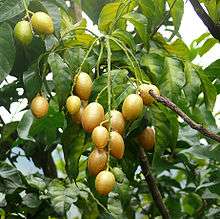Clausena
| Clausena | |
|---|---|
 | |
| Clausena lansium | |
| Scientific classification | |
| Kingdom: | Plantae |
| (unranked): | Angiosperms |
| (unranked): | Eudicots |
| (unranked): | Rosids |
| Order: | Sapindales |
| Family: | Rutaceae |
| Subfamily: | Aurantioideae |
| Genus: | Clausena Burm.f. |
| Type species | |
| Clausena excavata[1] Burm.f. | |
Clausena is a genus of flowering plants in the citrus family, Rutaceae. It was first defined by the Dutch botanist Nicolaas Laurens Burman in 1768. It is distributed in Africa, southern Asia, Australia, and the Pacific Islands.[2]
This genus is in the subfamily Aurantioideae, which also includes genus Citrus. It is in the subtribe Clauseninae, which are known technically as the remote citroid fruit trees.[3][4]
Clausena was named for the Norwegian clergyman, Peder Claussøn Friis (1545-1614), the translator of the Icelandic historian and poet, Snorri Sturluson.[5]
Description
The genus includes shrubs and trees. Some species are variable, with many forms. C. anisata, for example has been described as a shrub under a meter tall and as a tree of 20 meters.[3] The leaves of these plants are pinnate, divided into leaflets. The inflorescence varies in form, but is generally a cluster of several flowers with 4 or 5 petals and sepals. The fruit is a berry which lacks the pulp of many other fruits in the citrus family.[2] The genus can be distinguished from related plants by the presence of a gynophore, a structure supporting the ovary in the flower. It looks very different in the various species, however, and can be hard to recognize.[3]
Uses
C. anisata is a tree used for its wood,[6] and in traditional medicine.[7] C. excavata is used medicinally in Asia for a variety of conditions, including snakebite, malaria, dysentery, and HIV infection.[8] Some species, such as C. indica and C. lansium, produce edible fruit. The latter is cultivated as a fruit tree, and though it is only a remote ancestor of citrus, it can be grafted to various citrus trees. There are sour, sweet, and intermediate varieties.[3]
Diversity
The taxonomy of the genus is unclear.[3] There are between about 15 and 30 species.[2] Many formerly used names were made synonyms in a 1994 revision.[9]
- Clausena abyssinica
- Clausena anisata – horsewood
- Clausena austroindica
- Clausena brevistyla
- Clausena dentata
- Clausena engleri
- Clausena excavata
- Clausena harmandiana
- Clausena henryi
- Clausena heptaphylla
- Clausena indica
- Clausena inolida
- Clausena kanpurensis
- Clausena lansium – wampi, wampee, Chinese clausena
- Clausena lenis
- Clausena luxurians
- Clausena poilanei[9]
- Clausena sanki (syn. C. anisum-olens)
- Clausena smyrelliana[7]
- Clausena wallichii
References
- ↑ "Clausena Burm.f.". Australian Plant Name Index (APNI), IBIS database. Centre for Plant Biodiversity Research, Australian Government.
- 1 2 3 Clausena. Flora of China.
- 1 2 3 4 5 Swingle, W. T., rev. P. C. Reece. Chapter 3: The Botany of Citrus and its Wild Relatives. In: The Citrus Industry vol. 1. Webber, H. J. (ed.). Berkeley: University of California Press. 1967.
- ↑ Citrus Variety Collection. College of Natural and Agricultural Sciences. University of California, Riverside.
- ↑ "CRC World Dictionary of Medicinal and Poisonous Plants" - Umberto Quattrocchi (2012)
- ↑ Clausena anisata. Germplasm Resources Information Network (GRIN).
- 1 2 Forster, P. I. (2000). Clausena smyrelliana (Rutaceae: Aurantioideae), a new and critically endangered species from south-east Queensland. Austrobaileya 5(4) 715-20.
- ↑ Thongthoom, T., et al. (2010). Biological activity of chemical constituents from Clausena harmandiana. Archives of Pharmacal Research 33(5), 675-80.
- 1 2 Molino, J. F. (1994). Révision du genre Clausena Burm. f.(Rutaceae). Adansonia 1, 105-53.
- ↑ Clausena. The Plant List.
- ↑ GRIN Species Records of Clausena. Germplasm Resources Information Network (GRIN).